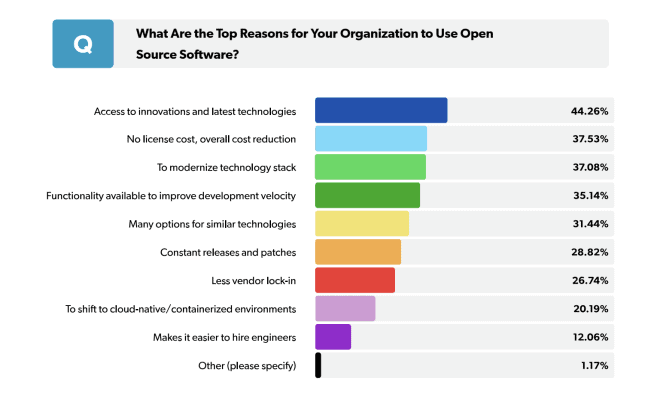If there’s one thing that’s been a constant in the past couple years, it’s economic uncertainty. From the covid shut downs and tech companies going on hiring sprees as their products and services surged in popularity, to the recent wave of layoffs at those same companies, both businesses and their employees are keenly aware of just how uncertain the economic landscape is these days.
For most, this uncertainty is likely seen as a negative; workers are concerned they’ll be caught in the next layoff (if they weren’t already) and business leaders are worried about budgets and adapting to the current state of things yet again. But in the realm of open source software, uncertainty can actually come with underlying benefits!
In fact, many IT leaders turn to open source specifically because of the uncertainty they’re facing. And in doing so they’re able to overcome previous technology limitations and save money at the same time. The result is a stronger, more robust organization with more cost effective and adaptive technology.
Economic Changes are Afoot
Right now we’re seeing the consequences of economic uncertainty daily within the stock market, and companies are reacting cautiously to signs of slowing profits. Specific to the technology sector, we’ve seen layoffs from companies like Salesforce, Amazon, and Vimeo in the past few weeks, not to mention others like Google. As the working world changed dramatically during the course of the pandemic, tech companies benefited and their teams grew.
Now that the economic environment has shifted, a lot of these same companies are downsizing in order to save money. And while it’s understandable, there are other specific strategic shifts in technology decisions that businesses can adopt when they need to save money, become more adaptable, and position themselves to weather the storm while staying successful.
Cost Savings Drives Open Source Software Adoption
Here at HotWax Systems, where our focus is on open source ERP solutions (Enterprise Resource Planning), we see a shift towards more open source software gaining momentum. These shifts can range from the adoption of small individual open source projects for a specific business use case to a large-scale replatforming of an open source enterprise ERP system.
Because uncertainty drives companies to start thinking in a more cost saving strategic sense, it makes sense to look for internal cost savings within an organization’s technology set. This naturally shifts a company’s focus to open source, which has no yearly license fees. Without license fees, companies can reduce many recurring technology costs while also benefiting from access to enhanced innovation and customizability that sets up their business for long term success no matter the economic landscape.
Some real life examples of companies saving on technology costs when adopting an open source software solution include the Brazilian government, which switched to open source in 2005 and expected ” …to save over $120 million…”, as well as Amazon.com, which “…cut $17 million (about 25%) from it’s technology expenditure by deploying a Linux-based infrastructure to process millions of transactions per day”.
Clearly, open source software is a fantastic solution for organizations looking to save money on their IT infrastructure. And the latest research supports this! In fact, cost savings is a leading impetus for companies to switch to open source platforms, along with access to innovation, according to The State of Open Source Report (2022).

Image taken from The State of Open Source Report (2022)
The Custom Software Benefit
Besides cost savings, open source software creates the freedom to customize the technology to your business’s specific needs. This is why access to innovation and current technology is the number one reason companies make the switch to open source; when a company adopts open source software, they are, for the most part, able to enhance the software any way they like. The ability to make software decisions specific to your business processes is a huge benefit of open source software adoption because you are able to give the business what it actually needs vs software that has been developed in a one size fits all model.
Adoption of Open Source Philosophy
Adoption of open source software can bring about a shift in business philosophy. The common term “build vs buy” is regularly used here at HotWax Systems, and some businesses are structured to build their own software systems and some are structured better to buy/ license software. When a company chooses to turn from proprietary software to open source, a shift in philosophy occurs as technology maintenance becomes an inside job.
The company will either need to grow in-house development teams to design and build their desired technology, or utilize an open source implementation specialist to lead and assist with the new open source software. Having an in-house development team working alongside an open source specialist produces efficient results and creates a recipe for the project’s success. Over time, the in-house team can assume the specific technology’s best practices to either take full control of the open source software or create a long term relationship with the implementation specialist to service the software for future needs.
Open Source Software – Better Than off the Shelf
There are many open source software analogies that exist today, but our most recent favorite in these uncertain times is that open source software is like a homegrown garden. Many people start a garden for fun, or because they heard the produce is higher in minerals, or they want to be more self-sufficient and spend less on groceries. What ends up happening is that not only do they end up having fun, collaborating with their friends, spouse or kids, and learning new things about plants, soil, ecology, etc. They also find that their food tastes so much better when grown at home.
Just like a garden, open source software is cultivated and grown to perfection by the open source community and the team of developers assigned to work on open source implementation projects. The combination of collaboration, expertise, creativity, and inherent customizability of open source software makes it like a garden.
Many organizations find open source for one particular reason such as looking to save money on their technology infrastructure. But once implemented, they find that not only did they save money, they also have access to the best talent, more and better innovation, and an ability to grow what they actually want and need within their business.
Like home garden grown produce, open source can be better than something purchased off the shelf. While the point of entry might be about cost, the full suit of benefits is what keeps more and more companies making the switch, and existing open source users happy and at the forefront of their industries.
Ben is VP of Sales at HotWax Systems and uses his strategic expertise and deep business knowledge to help match the best possible projects to skills and experience at HotWax Systems.


